|
Expectations of future inflation are informed by the past experience of consumers, both recent and distant. The longer inflation remains tame, the longer consumers extrapolate low inflation into the future even as evidence to the contrary begins to reveal itself. Wage and manufactured goods price inflation has been so low for so long that most of us can't recognize the shift to a more inflationary environment as it is happening today, but it is, as we'll show.
| Study the relationship between inflation expectations and all-items price indexes over time and you'll find that consumers form their short-term expectations of all-items price inflation based largely on current energy prices, and for good reason; all-items price inflation tracks energy price inflation closely as a major input cost both to producers and consumers. |
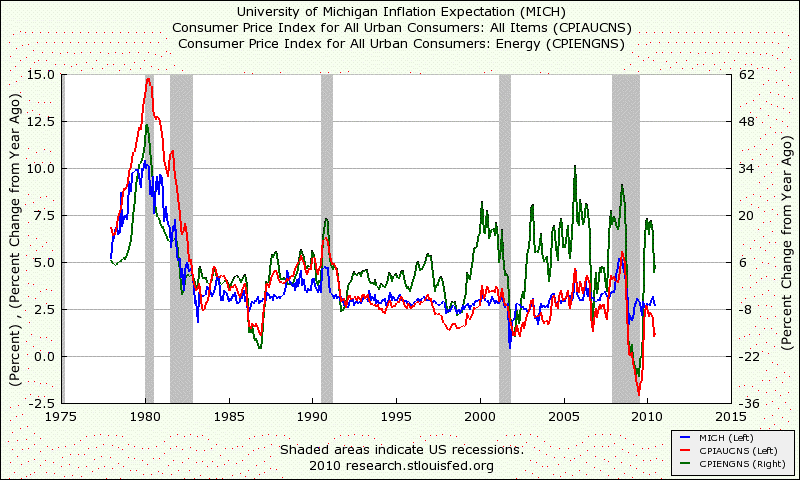
Click Here, or on the image, to see a larger, undistorted image.
For all practical purposes, today's consumer expectations for inflation a year from now are the same as today's energy prices. That's why monetary authorities focus on energy prices to manipulate both consumer and producer inflation expectations. As a deflation-fighting tool, abandoning the strong dollar policy in 2008 and allowing the dollar to depreciate was the most powerful weapon that policy makers had in the arsenal of deflation fighting tools in a zero interest rate environment. Rising oil import prices sent inflation price signals into the economy, pushing up the price of domestically produced oil and spreading price inflation throughout the entire commodity complex.
| Historically, after a period of rising energy price inflation and declining unemployment growth, the Fed steps in to lower inflation expectations by talking about raising interest rates, and then, depending on the market's response to the jaw boning, follows through sometime thereafter. |
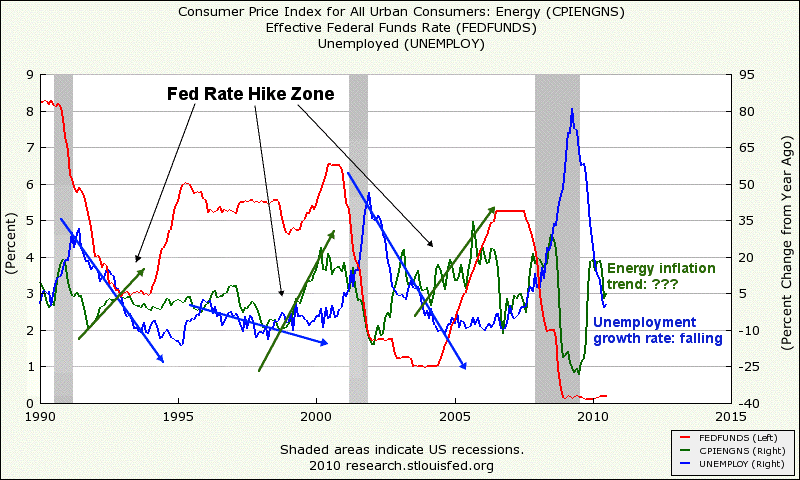
Click Here, or on the image, to see a larger, undistorted image.
The Fed Rate Hike Zone Formula Goes Something Like This:
If the rate of unemployment growth falls to 10% year over year and stops declining, and energy price inflation rises to a 5% annual rate, then begin a tightening cycle. Of course, there are many other variables in the Fed's decision formula, such as money growth and the ratio of non-performing loans, and no one but the Fed knows exactly what the formula is, but energy prices and unemployment are certainly key factors.
As high and inflationary as energy prices are today, they have stabilized and over the past few months and the rate of price growth, while still positive, has started to decline. It's too early to call this a trend; energy prices have been so volatile due both to giant fluctuations in demand during the recession as well as to economic policy measures taken to cope with the recession that it is impossible to say at this time which way energy prices will move over the next six months. That is the crux of the Fed's dilemma.
As the unemployment growth rate continues to fall, even if the unemployment level doesn't decline substantially, and if energy prices resume their rise then within a year, the Fed will be back in the hike zone. Even if energy prices don't rise further and simply remain in the $70s— recall $60 oil was called a "bubble" by Soros and others as recently as 2006— the kind of inflation that we have experienced for several years now will begin to influence inflation expectations for years to come.
Stealth Inflation
| The inflation we have experienced since early 2009 has so far not appeared as rising all-items prices but exhibits itself in ways that are familiar to older Americans who remember the early 1970s in the U.S. And, citizens of countries that have experienced a transition from a low to a higher inflation environment due to a weakening currency will also recognize the symptoms. |
To the uninitiated, the mix of price and quality changes of various goods and services gives rise to confusion and nonsensical terms like "bi-deflation." The purchasing power of income and savings is either rising or it is falling. It cannot be doing both at once, although a decline in purchasing power is expressed differently in the various goods and services prices depending on many factors. Here we tackle the three common inflation fallacies believed by Americans who have forgotten what inflation is all about.
Fallacy #1: When Unemployment Rises, Inflation Falls
We've locked horns for years with analysts who can't imagine how inflation can rise when jobs are scarce. Where is the competition for goods going to come from to drive up prices if consumers are cutting back on their spending to conserve savings, either because they are unemployed or are afraid they will be soon? That is certainly the environment that we see ourselves in today.
This sounds reasonable until you consider the case of India today where both unemployment and inflation are rising together.
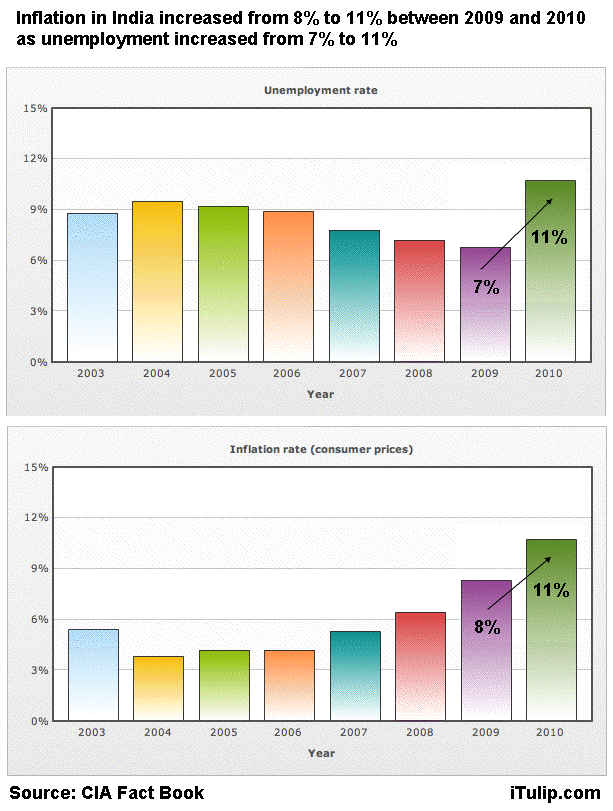
Click Here, or on the image, to see a larger, undistorted image.
How is rising inflation and rising unemployment possible? Because inflation is not only a factor of the supply and demand for goods but also of the supply and demand for the money used to buy the goods. Demand is determined not only by the level of desire of consumers to purchase goods but also their means to do so, the purchasing power of their income and savings. This leads us to the second fallacy of inflation. (Moreover, producers may cut goods supply even more quickly than consumers reduce demand, resulting in a goods supply/demand imbalance, albeit at a lower level than before the recession.)
Inflation Fallacy #2: Inflation Results From Too Much Money Chasing Too Few Goods
Four variables determine the way inflation is exhibited in prices:
- Supply goods
- Demand for goods
- Supply of money
- Demand for money
The deflationary price impact of falling consumer demand on a fixed quantity of goods supplied by producers is intuitive: prices fall as producers compete for fewer consumers. Likewise, if the demand for money rises faster than the money supply, the value of money rises and the result is deflationary.
Two dynamics trip up most observers.
| The first is the interaction of these four variables of inflation with each other as activist economic policy makers interfere with the market that would, if left to its own devices, allow prices to fall to meet the new lower level of demand. |
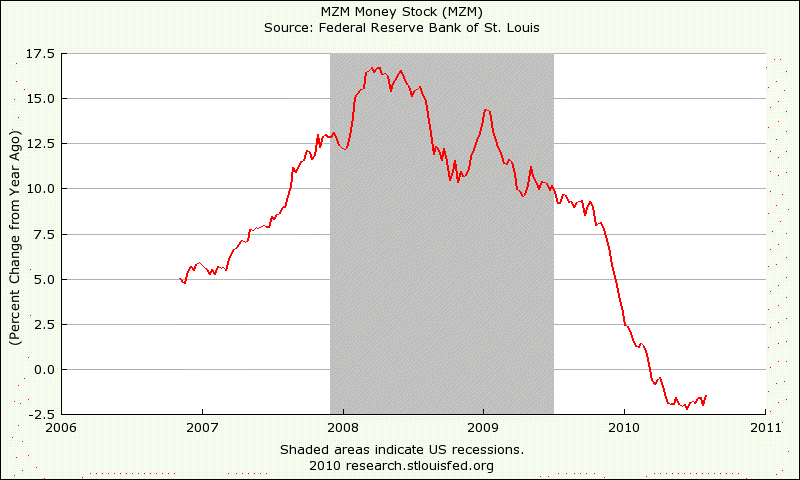
Click Here, or on the image, to see a larger, undistorted image.
| Money at zero maturity, a measure of the money supply closely watched by the Fed, averaged 10% growth rate during the recession, but has been declining overall since the start of the recession. This is typical of periods of weakness in the banking system when the ratio of non-performing loans are rising and the effectiveness of monetary policy to increase the money supply through the banking system is limited. |
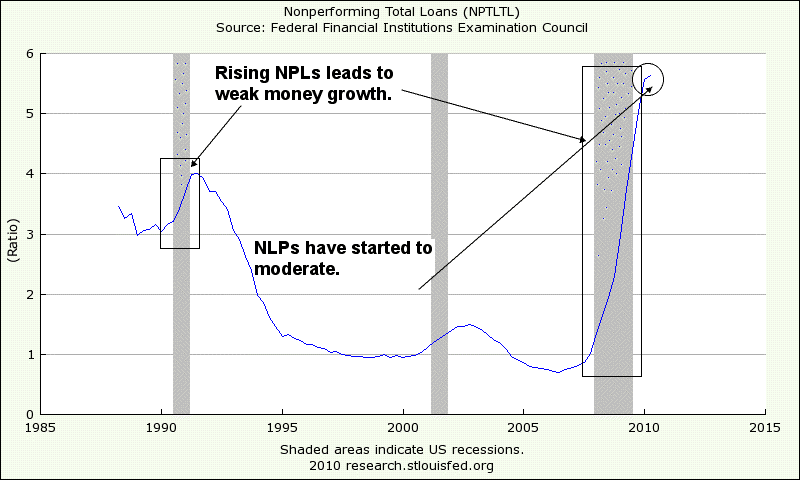
Click Here, or on the image, to see a larger, undistorted image.
| During recessions when NPL increased, the rate of MZM growth decreased. Recently, the level of NPLs started to decline and the velocity of MZM increased. |
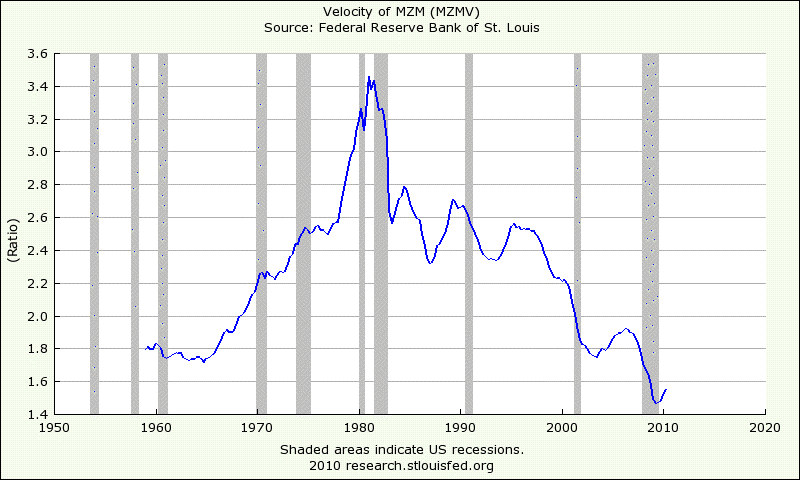
Click Here, or on the image, to see a larger, undistorted image.
| The view of disinflation inevitably arising from weak consumer demand in periods of rising unemployment is muddied by policies designed to stimulate money growth and delays between money growth and the appearance of inflation. The second dynamic of the four inflation variables that confuses most observers is the ability of producers to quickly withdraw supply in anticipation of declining demand. This was not the case in the 1930s when computer analysis tools to forecast future demand were unavailable. This is reflected in the rapid increase in capacity utilization since the official[!?!] end of the recession in late 2009. |
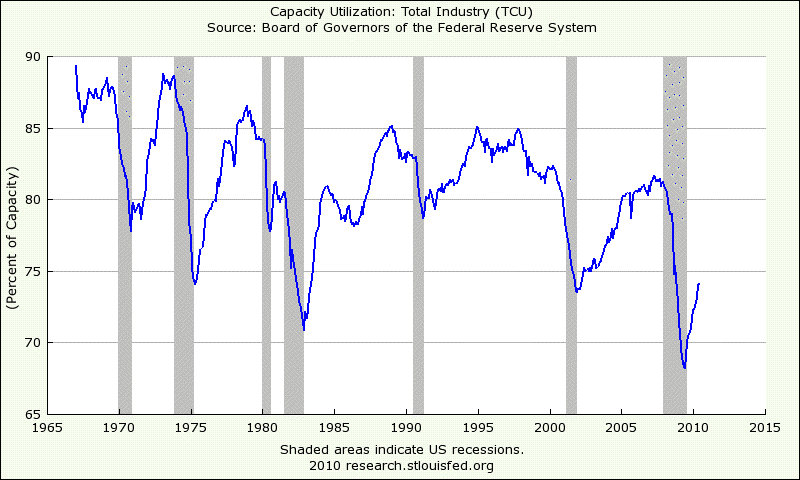
Click Here, or on the image, to see a larger, undistorted image.
| If rising inflation can attend rising unemployment, then it should not surprise readers to learn that low unemployment and rising wages can co-exist with consumer price deflation. Consider the case of Japan since 1999. |
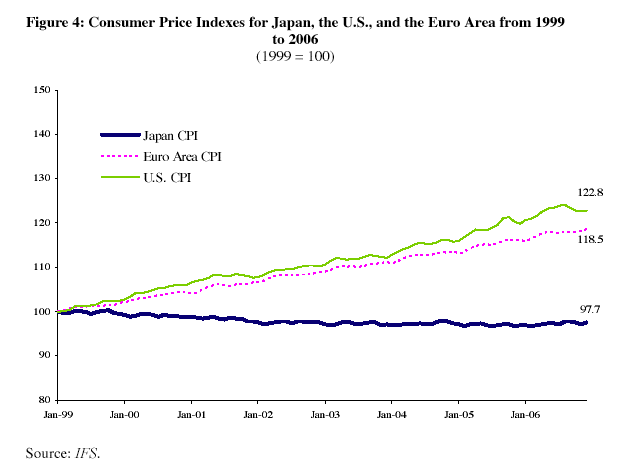
Click Here, or on the image, to see a larger, undistorted image.
Consumer price inflation fell…
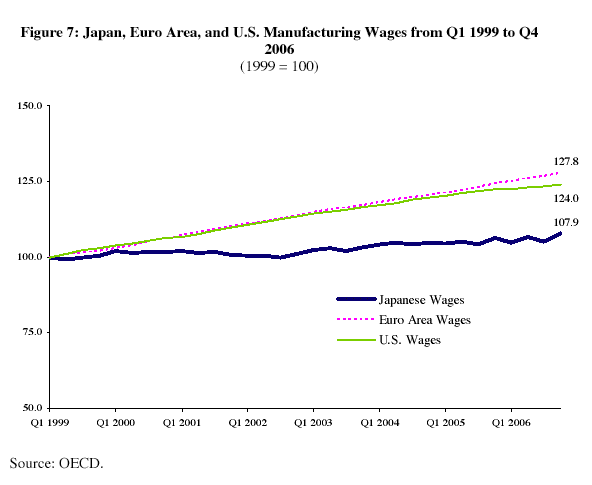
Click Here, or on the image, to see a larger, undistorted image.
…while wages grew.
| This is why most Japanese will tell you that they have experienced the past 20 years as a period of rising living standards. This leads us to our third inflation fallacy. |
Inflation Fallacy #3: Inflation Always Causes The Prices Of All Items To Rise At The Same Time
| This is the case after inflation expectations have been rising for an extended period, usually after several years, when expectations of high inflation have become deeply imbedded, but not during transitions from low to higher inflation. At first, inflation appears in those industries where producers have regained pricing power. An industry with pricing power is one that has consolidated to a single, dominant player that serves a market. For example, Walmart recently raised prices 6% in one month: |
|
Some Prices Hiked Over 60%?
|
In Japan, some industries experienced deflation while others have seen relatively high levels of inflation.
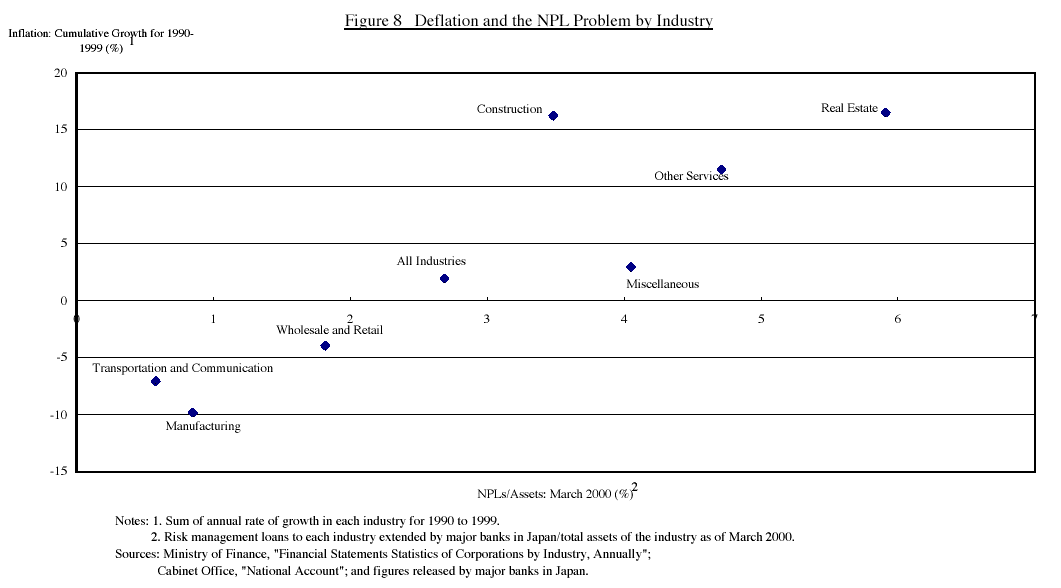
Click Here, or on the image, to see a larger, undistorted image.
| While Wholesale and Retail, Manufacturing, Transportation industries experienced deflation between 1990 and 1999 ranging from a cumulative -4% to -10% deflation while the Construction, Real Estate, and Services industries experienced a cumulative 11% to 17% inflation. The determinant factor: the ratio of non-performing loans (NPL) relative to assets of banks lending to those industries. Here in the U.S., early in our debt deflation process, there is a pattern of per-industry deflation and inflation developing. But for reasons of a more dynamic and self-correcting banking sector, the NPL problem for the U.S. will not be as great a deflationary factor here. |
For example, Walmart raised prices in response to weak consumer demand. That may strike some readers as backwards, but remember that as input costs rise, the company that can maintain the highest per-unit profit margins wins the positive cash flow contest in the long run. If input costs remain high, all producers and retailers must raise prices eventually, but the most efficient producers, wholesalers and retailers the least. We previously documented the other strategy of producers and suppliers to increase per-unit profitability, such as by reducing the size of portions in packaged products and the quality of ingredients.
Consumers today are reluctant to make purchase decisions unless they perceive that they are getting a "deal." At first glance this appears to be classic deflationary consumer behavior: purchase decisions are generally delayed by consumers who expect falling prices, which expectations are met by falling prices as the aggregate impact of the waiting behavior produces the expected result, a lower price as producers rush to meet the consumer's demand for a bargain because they have fewer dollars to spend, or are consumers trying to stretch a dollar of income that buys increasingly less, or both?
| Consumer behavior in an early transition from low to higher inflation varies depending on product. For many big-ticket consumer items, such as autos and major appliances, there is no urgency to go out and buy a product before the price rises. Take autos, for example. Sales unit volumes collapsed during the recession. As you'd expect, prices fell, too. |
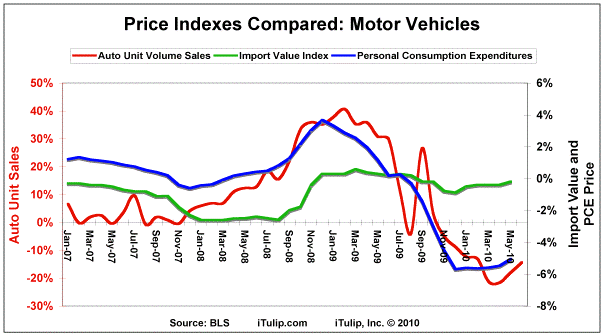
Click Here, or on the image, to see a larger, undistorted image.
Note, however, that even thought the Personal Consumption Expenditures price index for autos declined in line with unit volume, import prices did not. The reason is that exporters do not tend to lower prices as much as domestic producers do to meet lower market demand from an export market. They prefer, if they can, to increase sales in other stronger import markets. You can see a similar process with major appliances.
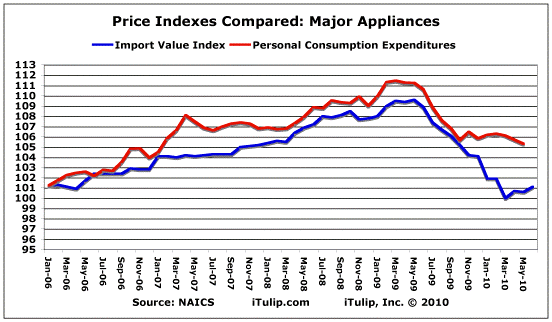
Click Here, or on the image, to see a larger, undistorted image.
| Prices on a PCE basis fell hard during the recession and have only recently begun to recover, but import prices of major appliances stabilized in the fall of 2009 as exporters adjusted to rising demand elsewhere. Also, the auto industry's loss was the auto parts industry's gain, as car owners and auto repair shops increased their purchases of parts to repair existing cars to keep them on the road longer. In this case, the domestic PCE price index increased faster than the import index. |
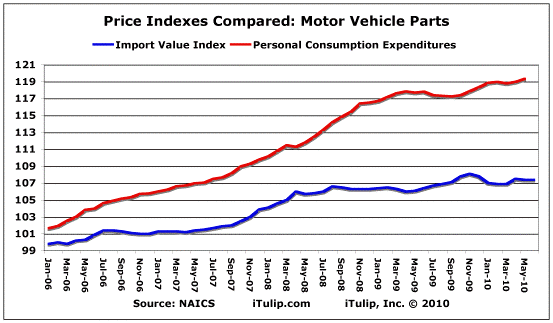
Click Here, or on the image, to see a larger, undistorted image.
Import prices are recovering to pre-recession levels.
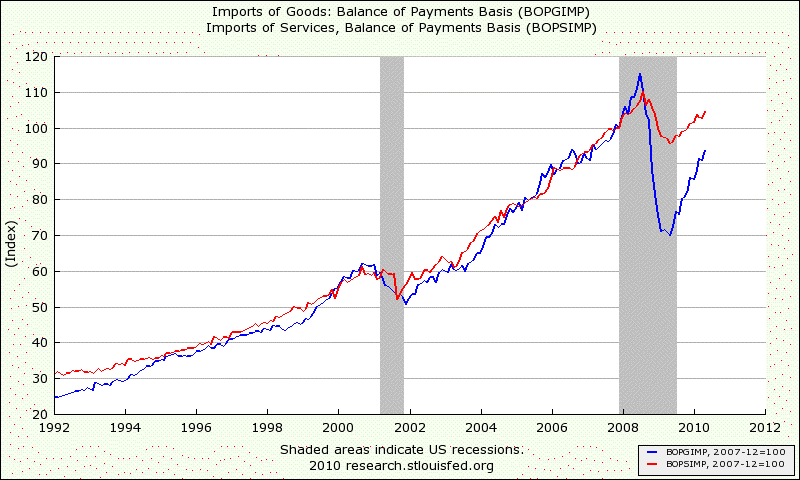
Click Here, or on the image, to see a larger, undistorted image.
Any attempt to depict the current environment as deflationary misses the devil in the details. High energy import prices, rising capacity utilization and velocity of money, and a leveling off of NPLs are typical of an inflationary not a deflationary price environment. In Part II we look deeper to find additional reasons for Bernanke to talk up 'deflation' while Keoll dissents with worry that the U.S. economy faces the opposite problem, inflation that may quickly turn into an inflation spiral that will be nearly as hard to manage in an environment of high unemployment as it was in the mid 1970s, but with the additional complication of asset price deflation.
 Inflation Is A Process, Not An Event— Part II
Inflation Is A Process, Not An Event— Part II• Will anti-asset price deflation policy trump commodity and wage inflation policy?
The primary stated mission of the central bank is to maintain commodity and wage price stability in the Productive Economy through adjustment to the money supply via interest rates and other means. As we explained to readers during the housing bubble, an unstated mission of the Fed is to promote asset price inflation in the FIRE Economy through interest rate policy and lack of enforcement of existing regulations of lenders, and lack of new regulations of new, destabilizing financial products.
The result of the Fed's "successful" execution of this dual mission: low commodity and wage inflation and a housing bubble. Some day asset price inflation will be regarded by central bankers as being as detrimental to economic growth as commodity and wage inflation but we're not there yet. We can look forward to several more years of government price supports of assets, with worries about commodity price inflation kept on the back burner.
The Fed's asset price inflation mission conflicted with the Fed's additional role as protector of banking and financial system stability. After the collapse of the housing bubble brought down the private credit markets and nearly collapsed the banking system, without any admission of failure, the Fed's mission abruptly changed.
The Fed's new mission is first and foremost to prevent asset price deflation in the FIRE Economy from spilling over into the Productive Economy via the credit markets and banking system. Commodity and wage inflation are now secondary concerns, and are believed to "take care of themselves" as long as unemployment remains high. But, as we have seen in the case of India in Part I, counting on unemployment to tame inflation is a dangerous gamble. If we look at the transition from low to high inflation in the 1970s period and compare it to the current era, that assumption may be seen to be especially perilous today.
ߧ
Normxxx
______________
The contents of any third-party letters/reports above do not necessarily reflect the opinions or viewpoint of normxxx. They are provided for informational/educational purposes only.
The content of any message or post by normxxx anywhere on this site is not to be construed as constituting market or investment advice. Such is intended for educational purposes only. Individuals should always consult with their own advisors for specific investment advice.
No comments:
Post a Comment